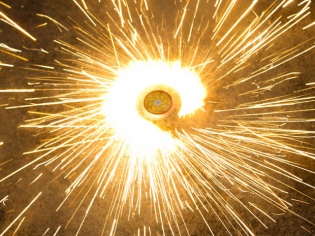-
Kamakshi S
04th Nov 2013
It's that time of year again when fire crackers (and a lot of smoke) will be seen across the skyline of the country. If you intend to capture a few such scenes with your DSLR this year, apart from a lot of practice and a whole lot of patience, what you'll need is a decent camera with aperture, shutter speed control, tripod, and possibly a remote controller. Once you have your gear in place, you can get started.
The first thing you need to figure out the ultimate location of where the fireworks explode. Once you've figured that out, you can set up the camera on a tripod and wait it out. Instead of mounting it horizontally, try using a vertical setup. That way, you can capture a lot of details, and you can crop it up later for a tighter angle. That said, you'd have to ensure that the tripod can handle the weight of your camera and in that position. Better to be safe than sorry, both when using crackers, and an expensive camera.
Make sure that you’ve set it on burst mode, as you can't really predict the trajectory motion or the timing of the fireworks coming to full glory. Instead of a wireless remote, which takes 2 secs to fire up, it's advisable to use a wired one as it's more responsive and quicker.
Once we have the leg work done, it's time to tweak settings on your camera. Firstly, this will not work on manual settings. So pick a semi-automatic mode — going full auto may result in the flash popping up, which will ruin your picture. So you can either pick A-Dep (semi-automatic), AV (aperture priority), TV (shutter priority), or SCN (night photography). While I stick to AV, you can try either of the four. While there is no thumb rule, the logic is fairly simple: Pick a mode that lets your camera recover and be ready for the next shot in the shortest time possible.

The perils of using a wide F-stop: Light trails!
EV: -1; F-Stop: f/2.8; ISO: 1600; Shutter Speed: 1/10.Next up is setting your Exposure Value, ISO, and F-Stop value. Many people are under the misconception that since you capture fireworks in the night, you need wide aperture. Nothing can ruin your shot more than high aperture value. Keep the f-stop between f/8 and f/10, because fireworks are very bright, and may appear washed out at f/2.8 or f/3. Try shooting a lit lamp, and you'll notice the difference when your point of focus rests on the burning flame.

EV: 0; F-Stop: f/4.5; ISO: 400; Shutter Speed: 1/40.Now what I do when capturing brightly lit objects in the dark is set the EV to as low as possible (between -1 and -2, or 0 and -1), so that maximum details can be seen. Since I shoot on JPEG+RAW; it also helps when post processing. So you can try anything that suites you best.

EV: 0; F-Stop: f/5; ISO: 400; Shutter Speed: 1/1000.Now, since these are not timed or coordinated fireworks, you'd ideally need some time to figure out where to point the camera, and how to use the lens' AF support. So make sure you have enough crackers to test settings with. While that is the case with firecrackers lighting up skies, flower pots and other land-based crackers are easier to capture, because you know where they will be even after you light them. The only downer here is that the more colourful the cracker, the more smoke it emits. So not only is it bad for the environment, your shots may come out hazy too. So be careful when you capture these.

EV: 0; F-Stop: f/5.6; ISO: 400; Shutter Speed: 1/60.While we don’t advocate bursting crackers (and burning money and the environment, literally), you are likely to find plenty of test subjects. Here's wishing everyone on behalf of Team TechTree.com a safe and happy Diwali.
How To Capture The Firework Display Better This Diwali | TechTree.com
How To Capture The Firework Display Better This Diwali
Capture the essence of the festival of lights through your DSLR.
News Corner
- DRIFE Begins Operations in Namma Bengaluru
- Sevenaire launches ‘NEPTUNE’ – 24W Portable Speaker with RGB LED Lights
- Inbase launches ‘Urban Q1 Pro’ TWS Earbuds with Smart Touch control in India
- Airtel announces Rs 6000 cashback on purchase of smartphones from leading brands
- 78% of Indians are saving to spend during the festive season and 72% will splurge on gadgets & electronics
- 5 Tips For Buying A TV This Festive Season
- Facebook launches its largest creator education program in India
- 5 educational tech toys for young and aspiring engineers
- Mid-range smartphones emerge as customer favourites this festive season, reveals Amazon survey
- COLORFUL Launches Onebot M24A1 AIO PC for Professionals







TECHTREE